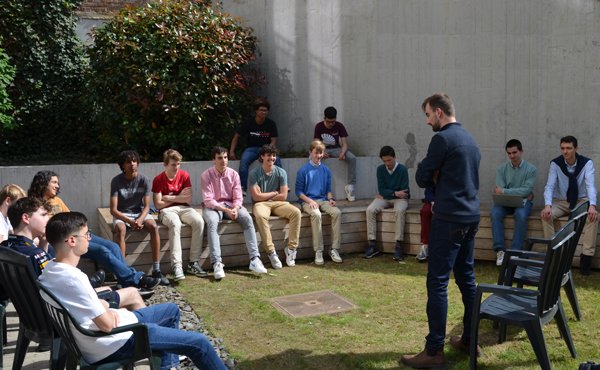He also made time to visit the Narval Club, a youth center located in Woluwe-Saint-Pierre, which provides Christian formation entrusted to Opus Dei. The center is preparing to celebrate its 50th anniversary soon.
Since 25 March 2023, Henri d’Anselme has been on a journey across France with his backpack, traveling on foot or hitchhiking to visit the country’s 180 cathedrals (he has about 30 left to see). “The idea of this cathedral tour came to me during high school when I was 14 or 15. Initially, it was an adventure; a pretext to travel around France. But on 15 April 2019, while I was at university, I watched Notre-Dame de Paris burn. It deeply affected me. Just a week before, I had venerated the Lord’s Crown of Thorns at the cathedral.”
During this pilgrimage, Henri witnessed a harrowing scene in Annecy on 8 June of the same year. He saw a man with a knife attacking children. “I had three options: film, flee, or act. Without fully understanding why, I stepped in. It lasted five minutes that felt like an eternity. Since I immediately had to give my deposition at the police station and hadn’t eaten, I had a hypoglycemia episode,” he recalls.

Images of Henri thwarting the attacker spread across France and the world. “When I got home, my phone didn’t stop ringing for hours. All the TV channels wanted to sign a contract with me. At the time, I was unemployed and looking for a job. My phone number was on my LinkedIn page, so I was easy to find. I had worked in communications previously, and I signed with Canal+ to make documentaries about cathedrals.”
This unexpected fame—Henri was awarded the Légion d’Honneur for his bravery—allowed him to share the central message of his pilgrimage, which aligns with the vision of the cathedral builders. These men committed to constructing enduring “free beauty” for generations to come, contrasting with our contemporary approach of building quickly, cheaply, and functionally. Cathedrals, he explains, are “like a bridge between heaven and earth. That’s why they have spires. This gift needs to be received, understood better, and thus loved more.”
The cathedral builders created a lasting work for us, for the soul, and for God. They convey a message for an era that tends to prioritize “utility over beauty, efficiency over goodness, and profitability over truth,” Henri believes. “Rebuilding Notre-Dame [was] about rebuilding ourselves, restoring our souls. Notre-Dame de Paris will be magnificent.” His message is one of hope and perspective for young people—and for everyone.
